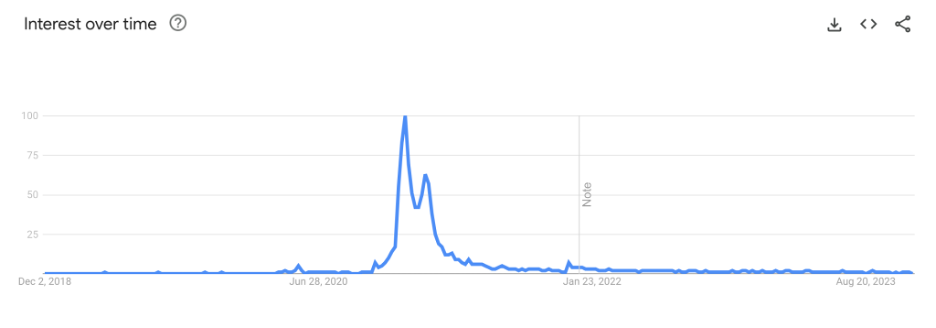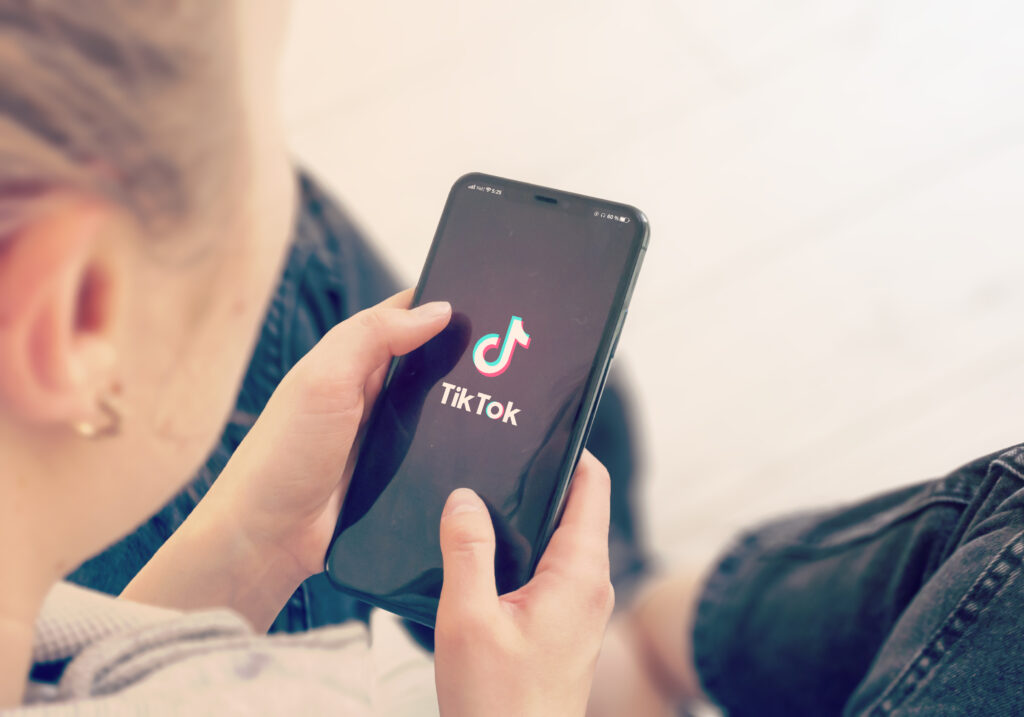Most brands already see the marketing value of social media content, at least in theory. But unless they’re firmly focused on the youth market, many still stick to social media’s elder-statesmen: Facebook, Twitter (now X), and Instagram, all of which have at least a decade of traction—millennia in internet years.
TikTok—the fast-moving, video-centric social media platform preferred by Generation Z —still seems to get cautious glances from more than a few marketing departments. Only 18% of marketers were using TikTok in 2023, which may have something to do with the fact that a full third of U.S. adults had an unfavorable view of the social media app.
It’s understandable to be cautious about dumping marketing dollars into another social media app—we’ve all watched next-big-thing social platforms like Clubhouse peak and crash, attention-wise, in a blink.
CLUBHOUSE INTEREST

Popularity of “Clubhouse app” search term on Google Trends
TikTok, however, muscled through its first five years with zero signs of burnout.

TikTok usage chart from Business of Apps
2023 TikTok Statistics for Marketers
With TikTok continuing to command attention, is it time for more marketers to start leveraging the platform for brand awareness and user engagement? Looking at the data, that already seems overdue.
Here’s what TikTok traffic looked like in 2023:
- More than 1.6 billion users globally
- 150 million U.S. users
- Over 1 billion videos viewed daily
- Potential ad reach of more than 1 billion adults
TikTok’s total user number may be almost 36% less than Instagram’s 2.3 billion, but by 2023, Instagram already had 13 years to grow (and the power of social media behemoth Meta behind it).
TikTok launched in China in late 2016, and was worldwide by early 2018. That’s a long enough track record to validate staying power, but TikTok’s still a newcomer in comparison to Meta’s Facebook, born in 2004.
TikTok’s rapid and sustained growth might seem surprising to some marketers, but plenty of experts saw signs of significance early on—in 2019, The New York Times already felt strongly enough to explore “How TikTok Is Rewriting the World.”
Understanding TikTok’s Influence
Why has TikTok succeeded with everyday users (and, increasingly, brands) where so many social media apps have failed? (Even the eerily similar Vine, which rocketed to prominence in 2012 before flaming out for good in January of 2017.) The TikTok platform has a few key things going for it:
- The Right Timing
TikTok filled the void left by Vine, which allowed the platform to capture an audience that already loved (and craved) short, engaging video content.
- A Focus on Short-Form
Our rapidly shrinking attention spans mean users are primed for quick content consumption, and TikTok catered explicitly to that. The platform’s short, easily scrollable videos appeal to people more likely to watch a 10-second clip than a longer video (which, studies seem to indicate, is a lot of us), making the content engaging and thoroughly addictive. Data to back up that addictive quality: TikTok users spend an average of 95 minutes on the app daily.
- A Different, Powerful Algorithm
On most social media platforms, your feed delivers a blend of content from accounts you follow and from ad partners, with some personalized recommendations thrown in. TikTok’s algorithm is different, designed to deliver more and more of what you like (i.e. interact with), regardless of who you do and don’t follow. It’s exceptionally adept at learning user preferences based on their activity, and its sharp curation ensures that users are continuously fed videos that satiate their interests (even if those interests aren’t what they’d outwardly admit to with a “like” or “follow”).
- An Easy, Flexible, Colorful Interface
Users seem to love the process of making/editing videos on TikTok nearly as much as sharing and consuming them. The app simplifies the process of video production to make it approachable for nearly anyone, allowing users to effortlessly record, personalize, and upload content. The vast library of audio tracks, effects, and filters make it that much more appealing, too.
- An Emphasis on Engagement
TikTok is famous for its churn of trends and challenges, which evolve and adapt with the cheetah speed of modern-day attention span. From its early days, TikTok encouraged users to kick off a challenge—like Jimmy Fallon’s TikTok #TumbleweedChallenge—and invite others to add their own spin. This approach keeps users engaged, encourages content creation, and steadily seeds virality that almost any user can get a chance at.
- Local Flavor
TikTok is a global app, but it’s consistently emphasized localized content, from local competitions to regional trends served up via specific hashtags. (While hashtags are fading from view on most social apps, they still have power on TikTok.) The localization keeps users connected in a personalized way.
TikTok User Demographics
For marketers, audience is the key question. We’re not doing our jobs if we don’t start the conversation with, “Who am I talking to, and what do they need?” So before you go diving into developing a TikTok marketing strategy, questioning demographics and audience makes good sense.
So, who are we talking to here? Let’s look at TikTok user data.
- Lots of Americans
The U.S. has the most TikTok users (150 million), though the app’s audience spans the globe.
- Mostly Folks Under 50
Add up all users 18-44 and you have about 86% of TikTok’s user base covered. The largest group (37%) is 18-24, with 25-34 following closely behind (at 33%).
- All Genders
If you’re looking to target men or women, specifically, on TikTok, you’ll hit both— it’s an even gender split, audience-wise.
- Users Who Are Ready to Spend
In Q1 2023, TikTok crossed the $1 billion/quarter threshold in customer spending.
- Consistent Scrollers
Average TikTokkers put in 26 hours a month and open the app nine times a day.
- Music Lovers
75% of users say TikTok helps them find new songs.
- Users Who Want to Learn
While entertainment, dance, and prank content dominate on TikTok (and it’s by a lot), the most popular categories still show breadth. Fitness/sports, home renovation, beauty, fashion, and pets are all in the top 10, which are topics that can connect comfortably to a massive number of brands.
If you’re hoping to engage a younger audience, TikTok might be your social-media answer. Legacy media stalwart The Washington Post did exactly that, utilizing TikTok in an appealing, organic way that’s forged a deep connection with a demographic their print product (and to a lesser extent, digital product) hasn’t traditionally engaged. (When this post went up, the WaPo TikTok had about 85 million likes.)
Crafting a TikTok Marketing Strategy
A robust TikTok marketing strategy goes beyond editing and posting videos; it starts with an understanding of the platform’s unique algorithm, user preferences, and the way people prefer to engage on the app.
As with all social media content strategies, there’s no one-size plan for every brand. But these baseline tactics can inform the way you wade in.
1. Embrace TikTok Trends
TikTok’s always-evolving trends are pivotal in driving user engagement. Tracking trending audios, hashtags, and challenges can help you to tap in and remain relevant. Sprout Social has a great primer of the TikTok Challenge fundamentals, and Buffer has a good breakdown of how to find trending audio on TikTok.
This is a well-established tactic for a bunch of brands, from Guess with their viral #InMyDenim campaign to Chipotle’s Shorty Award-winning #LidFlip challenge. But keep your marketing fundamentals intact when chasing trends—if something doesn’t align with your brand’s voice and mission/vision naturally, don’t force it.
2. Lean Into Authenticity
Authenticity is key across social media, but especially on TikTok. Brands should aim for content that’s honest, relatable, and real. Whether it’s behind-the-scenes footage, user-generated content, or heartfelt storytelling, your content should feel genuine and reflect your brand’s personality without pretense.
One authentic brand TikTok case study: the NBA’s TikTok, which showcases player highlights and behind-the-scenes footage that aligns squarely with the platform’s strengths and its users’ preference for authenticity and fun.
3. Test Out Influencer Marketing
Influencer/creator collaboration is another well-established tactic that’s proved successful for brands big and small on TikTok. One example: Chips Ahoy! put TikTok influencer marketing into practice for the brand’s 60th birthday, expertly tapping a cast of creators to juice top-of-funnel interest.
There are lots of TikTok influencers to choose from (more than 100,000) and they tend to get higher engagement rates than the average on Meta’s platforms, too. Nano-influencers on TikTok (1,000-10,000 followers) get an average engagement rate of 15.2%, which, if you regularly track social engagement rates, looks like a wildly high number.
The right influencer collaborations can amplify your brand’s reach and get a new audience excited about what you do. The key word there is “right.” Successful influencer partnerships need to be with creators whose style and audience align with your voice and mission—or better still, creators who genuinely care about and endorse your brand.
4. Tap Into TikTok Advertising
TikTok advertising comes in diverse ad formats, each with their own unique engagement opportunities. From in-feed ads to branded effects, the platform’s versatile options can allow your brand to creatively (and authentically) showcase what you do, make, and offer.
One of the great things about TikTok as an ad platform: TikTok for Business is rich with resources, ideas, and specifics, and understanding the nuances of TikTok Ads Manager is a lot more approachable than… some social media ad managers (if you regularly advertise on social media, you know the one).
A small business can take on TikTok advertising by poring through the educational content on TikTok for Business, then testing, analyzing and tweaking. If you need professional help launching a TikTok ad campaign, though, Snapshot’s Digital Team is always here to support.
Snapshot: Your Social Media Marketing Partner
We do a lot more than TikTok ads here at Snapshot. Even just on the social media marketing front, we handle anything from full-scale organic content strategy and management to focused, multi-platform social media ad campaigns.
We shape custom social media marketing plans for a wide range of clients, all focused around their goals, needs, and brand missions. Looking to wade into TikTok ad content? Or need a more holistic social media overhaul? Contact Snapshot, tell us about your brand and your plans, and we’ll get to work.








